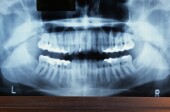High risk for zoledronate, denosumab mainly in prevention of skeletal-related events
MONDAY, Aug. 31, 2015 (HealthDay News) — The risk of osteonecrosis of the jaw (ONJ) is highest in association with intravenous bisphosphonate use, according to a study published online Aug. 19 in the Journal of Bone and Mineral Research.
Xiaoyan Zhang, M.D., Ph.D., from the College of Pharmacy at the University of Florida in Orlando, and colleagues analyzed ONJ cases and associated drugs in the U.S. Food and Drug Administration’s adverse event reporting system (FAERS). The authors identified 17,119 unique ONJ cases.
The researchers found that the drugs with the highest reporting odds ratios were bisphosphonates: pamidronate, zoledronate, and alendronate (odds ratios, 498.9, 171.7, and 63.6, respectively); denosumab had lower odds ratios than all bisphosphonates except etidronate. The lowest odds ratios were seen for antiangiogenic agents and m-TOR inhibitors. The reporting odds ratios for cancer patients who were treated for prevention of skeletal-related events (SREs) were 125.2 for zoledronate and 4.9 for denosumab. The odds ratios for zoledronate and denosumab were 1.1 and 0.63, respectively, in patients with osteoporosis.
“In conclusion, our analysis of the FAERS system showed that the intravenous bisphosphonates had the highest risk for drug induced ONJ,” the authors write. “The high risk for ONJ in zoledronate and denosumab was mainly observed in those who were treated for prevention of SREs, while there was limited evidence for such risk in those who were treated for osteoporosis.”
Copyright © 2015 HealthDay. All rights reserved.








